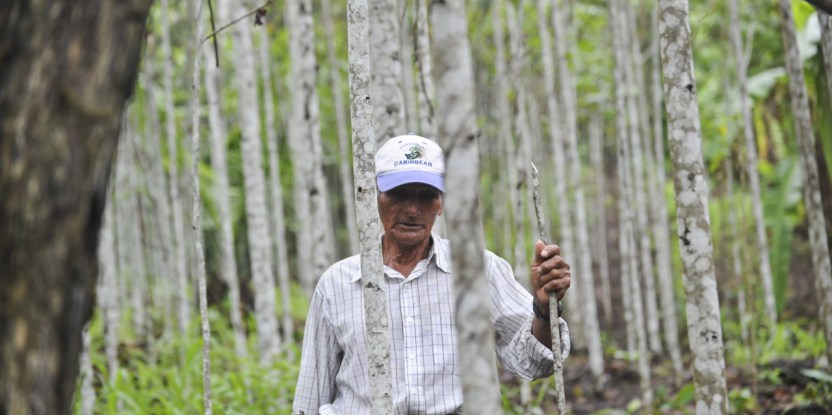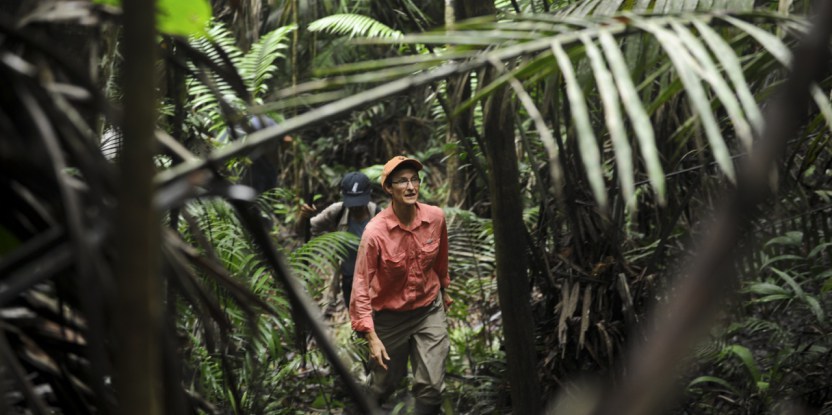
Editor’s Note: This is the second of a series of articles about CIFOR’s research on smallholder bolaina logging in the Amazon. Part 1 can be read here.
CONTAMANA, Peru — When Belisario Villacrez divided his land among his children, one son planted cacao, Peru’s newest “boom” crop. However, in this remote corner of the Amazon, inaccessible by road, his gamble went bust when he could not sell his produce.
So when researcher Robin Sears asked Villacrez if he would rather take out a loan to plant cacao or to manage bolaina (Guazuma crinita), a fast-growing tree that sprouts in fallow fields, the farmer did not hesitate.
“Bolaina,” he said, “because you can’t always find a buyer for cacao.”
Many tree species are more valuable than bolaina, but few are as easy to grow — the sun-loving species appears quickly in fallow fields and can be ready for harvest within a few years with minimal silvicultural intervention.
Cutting and selling the timber legally, however, is expensive and complicated for smallholders, because forestry regulations were designed with larger logging operations in mind, leading to prohibitive overhead costs.
Researchers with the Center for International Forestry Research (CIFOR) are studying the production and marketing of bolaina with an eye to suggesting management practices and policies that could help smallholders produce more the wood efficiently without hurting the forest.
Like Villacrez, many farmers around Contamana have bolaina growing in their fallow fields, often with very little management — they keep seed trees around and they may thin the stand, but nature does the rest. The farmers know that if they just leave it to grow, they can sell the trees if they need quick cash.
“The question I’d like to answer is what would it take to help them engage in the purposeful production of timber, rather than just letting it happen,” said Sears, a CIFOR consultant and vice president for academic affairs at the U.S.-based School for Field Studies, which offers study-abroad environmental programs in nine countries.
“Some smallholder farmers take a very active approach to promoting the growth of these timber species, such as thinning and weeding the stands,” Sears said. The CIFOR team is promoting farmer-to-farmer knowledge exchange, while working with the forest authorities on “liberating” fallow timber from the most onerous of forestry regulations.
Bolaina has traditionally been used in places such as Contamana as a cheap wood for construction, and many houses around town are made of bolaina boards. Demand for bolaina surged in 2007, after a strong earthquake leveled the city of Pisco, on Peru’s southern coast, and manufacturers bought large amounts of the wood for prefabricated houses.
Now there is a market not only locally, but also in highland and coastal cities. The researchers are trying to determine how farmers can take better advantage of that demand.
In interviews with smallholders around Contamana about their management practices and engagement with the market, Sears said she and research assistant Matías Pérez have found that “every case is different, according to their land tenure status, availability of labor, and distance to transport services.”
But one thing the smallholders have in common is that their incomes are low. Their farms — mosaics of mature forest, small fields, fallows and secondary forest — provide a subsistence income.
PLANNED PRODUCTION
For most, the sale of bolaina provides an emergency reserve. They sell the timber if they need quick cash for unexpected expenses, such as medical emergencies.
“But when they sell it quickly, they get a lower price,” said Sears, who would like to see smallholders receive a steady income from the bolaina in their fallows. “It needn’t serve only as an emergency fund. With some planning, this fast-growing timber could provide regular income.”
Planned rotation of fallows so there are bolaina stands ready to harvest every couple of years would give farmers “a giant injection of between $350 and $700 per hectare” every few years, she said.
They’ll change the way they do things when they know the sweet taste of success, but the shift also requires supportive conditions in land tenure, regulations, and finance
Lirio Rodríguez, 72, whose farm is down the road from Villacrez’s, has a more ambitious vision. He would like to see four or five smallholders join together to purchase a small, portable sawmill so they can cut their own timber and mill the logs into rough-cut boards.
Selling 200 standing trees of commercial size, the average for one hectare of managed fallow, for harvesting by a woodcutter known as a bolainero nets a farmer about $370. That figure doubles if the landowner cuts and sells the logs. However, the net income to the landowner on the same hectare of bolaina can be upwards of $2,000 if she or he can produce the milled boards, called tablillas, on site.
So far, however, the investment of between $1,500 and $2,000 has put a portable sawmill and other equipment out of the smallholders’ reach.
Adding value to the milled lumber by turning it into furniture or other items is also difficult, town officials say. Because Contamana is not on the country’s electricity grid, the cost of electricity from the town’s diesel-powered generator would make a manufacturing plant too expensive.
But one of the biggest obstacles smallholders face is the law. Many still lack legal title to their lands, although some have obtained their titles since Sears interviewed them in 2007. Without a title, farmers usually cannot qualify for loans or government assistance programs.
Peru’s forestry regulations are being revamped this year, and the researchers suggest that this could provide an opportunity to include policies that would enable farmers to sell bolaina and other fast-growing trees that appear in agricultural fallows and abandoned fields.
The policies should include safeguards to ensure that the timber actually comes from fallow fields and not from mature forest, Sears said, adding that Brazil, which has had such regulations for about a decade, could serve as a model.
Another challenge is to encourage farmers to manage their stands of bolaina, clearing underbrush and thinning the seedlings to optimize production. That would require a “cultural shift,” which could be hastened by enabling smallholders to visit places where farmers are managing timber from their fallows, Sears said.
Altering farming practices is not easy, she says, “farmer-to-farmer exchanges can help. They’ll change the way they do things when they know the sweet taste of success, but the shift also requires supportive conditions in land tenure, regulations, and finance.”
For more information about the topics in this article, contact Peter Cronkleton at p.cronkleton@cgiar.org.
This research is carried out by CIFOR as part of the CGIAR Research Program on Forests, Trees and Agroforestry and is supported by the United States Agency for International Development.
We want you to share Forests News content, which is licensed under Creative Commons Attribution-NonCommercial-ShareAlike 4.0 International (CC BY-NC-SA 4.0). This means you are free to redistribute our material for non-commercial purposes. All we ask is that you give Forests News appropriate credit and link to the original Forests News content, indicate if changes were made, and distribute your contributions under the same Creative Commons license. You must notify Forests News if you repost, reprint or reuse our materials by contacting forestsnews@cifor-icraf.org.

